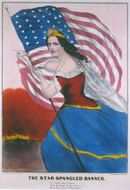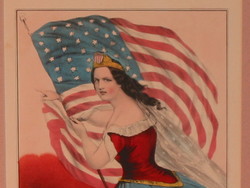

Obverse

Ob. Top

Ob. Center

Ob. Bottom

Back label

Obverse on side

Reverse

Book Photo

Corner Detail
Lithograph "Star Spangled Banner", Currier & Ives.
Sub-collection: Maps & PrintsA stunning period lithograph capturing the essence of American liberty.
This lithograph, produced by Currier & Ives in the mid-to-late 19th Century depicts the two principal pillars of American identity; unity, represented by the Star Spangled Banner and liberty, rendered as Lady Liberty.
Used as the frontispice in the book "The American Flag:Two Centuries of Concord and Conflict" 2007, VZ Publication, Santa Cruz, Ca.
This lithograph bears the Star Spangled Banner and Lady liberty, crowned with an American crest, who bears the American flag as she points forward to victory. The fires of battle burn in the distance -- presumably the defense of Fort McHenry by American forces during the British attack on September 13, 1814 (during the War of 1812); the conflict which inspired Francis Scott Key to write 'The Star Spangled Banner'.
Several phrases from the song The Star Spangled Banner serve as the title printed in the lower margin: "O! long may it wave,/ O'er the land of the free,/ And the home of the brave."
The lithography firm of Currier & Ives was founded in 1834 by Nathaniel Currier as N. Currier, Lithographer, and based in New York. In 1852, he brought his brother-in-law, James Merritt Ives, into the business and renamed the firm Currier & Ives five years later. They were extremely prolific and highly successful, producing almost 7,500 different art prints issued separately throughout the 19th century until 1907; aptly advertising themselves as "Print-makers to the American People." Their prints were issued in small, medium and large folios, though some particularly popular images were issued in more than one size.
Dozens of American artists in the mid 19th century painted primarily for lithographic reproduction enterprises run by Currier & Ives and other firms. To please a broad audience, the firm presented a warm and positive vision of America, frequently sentimental, and sometimes with a touch of humor. Currier & Ives prints generally portrayed the American landscape, scenery and landmarks, including the westward expansion, as well as daily life in both urban and rural settings. Their sporting and maritime subjects were particularly popular. These prints are now highly desirable as a record of 19th century American history, as fine works of American art, and for their decorative appeal.
This is a well documented Currier & Ives Lithograph - Conningham #5707 & Gale #6119
Exhibition History:
First Presidio Exhibit
(ZFC0315)
Lithograph, "The Star-Spangled Banner"
Second Presidio Exhibit, 2003- Gallery II
(ZFC0315)
The Star Spangled Banner Lithograph
Provenance: Acquired by the Zaricor Flag Collection (ZFC0315) in 1998 from Wesley Cowan Auction of Cincinnati, OH.
ZFC Significant Flag
Item is Framed
Sources:
"The Star-Spangled Banner", Wikipedia, 20 November 2011, from: http://en.wikipedia.org/wiki/The_Star-Spangled_Banner
Currier and Ives, Wikipedia, 20 November 2011, from: http://en.wikipedia.org/wiki/Currier_%26_Ives
Newman, Robert K., December 2000, Brief History of N. Currier and Currier & Ives., The Old Print Shop, 5 October 2011, from:
http://www.oldprintshop.com/artists/currier-ives-history.htm
Currier & Ives, George Glazer Gallery, 20 November 2011, from: http://www.georgeglazer.com/prints/americana/americana.html?tab=2
Image Credits:
Zaricor Flag Collection
Item is Framed
Hoist & Fly | |
|---|---|
| Width of Hoist | 9.5 |
| Length of Fly | 13.5 |
Frame | |
|---|---|
| Is it framed? | yes |
| Frame Height | 16.5 |
| Frame Length | 20.5 |
| Comments on Frame | Framed 20.5" x 16.5" |
Stars | |
|---|---|
| Are there stars on obverse? | no |
| Are there stars on reverse? | no |
Stripes | |
|---|---|
| Has a Blood Stripe? | no |
Nationality | |
|---|---|
| Nation Represented | United States |
Fabric | |
|---|---|
| Fabric | Paper |
Applica | |
|---|---|
| Applique Sides | Single Sided = Design on one side only |
Condition | |
|---|---|
| Condition | Good |
| Damage | used |
| Displayable | yes |
Date | |
|---|---|
| Date | circa 1870's-1880's |
Exhibits | |
|---|---|
| Exhibition Copy | First Presidio Exhibit (ZFC0315) LITHOGRAPH, “THE STAR-SPANGLED BANNER†Date: About 1860-1880 Medium: Lithograph on paper Comment: During the third quarter of the nineteenth century, the lithographic firm of Currier & Ives mass-produced great numbers of patriotic and sentimental illustrations for public consumption. The insult to the United States flag flying over Fort Sumter resurrected the memory of another U.S. flag flying over another fort under attack – Fort McHenry in Baltimore Harbor during the British bombardment of the night of September 13th, 1814. That attack caused Francis Scott Key to pen the poem (almost immediately set to music) “The Star-Spangled Bannerâ€. Although the original “Star-Spangled Banner†had disappeared into private hands at the outbreak of the Civil War, the fifteen-star, fifteen-stripe flag’s image still resounded as a patriotic appeal. The original flag now resides in the collections of Smithsonian Institution and is undergoing extensive conservation. Provenance: Acquired by the Zaricor Flag Collection (ZFC0315) in 1998 from Wesley Cowan auction of Cincinnati, OH. Second Presidio Exhibit, 2003- Gallery II (ZFC0315) The Star Spangled Banner Lithograph Date: About 1860–1880 Media: Lithograph on paper Comment: During the third quarter of the 19th century, the lithographic firm of Currier & Ives mass-produced patriotic and sentimental illustrations for public consumption. While today this lithograph may seem to be only a generic tribute to the national flag, it held special meaning at the time it was produced. The 1861 assault on the United States flag flying over Fort Sumter was fresh in the minds of the general public. It resurrected the memory of another U.S. flag flying over a fort under attack—Fort McHenry in Baltimore harbor during the British bombardment on the night of September 13, 1814. That event had resulted in the penning of a poem (almost immediately set to music) by Francis Scott Key, “The Star-Spangled Banner.†Although the original Star-Spangled Banner had disappeared into private hands long before the Civil War, the name and image of that 15-star, 15-stripe flag still resounded as a patriotic appeal. Today the original flag is considered to be the premier item held by the Smithsonian Institution, where it is currently undergoing extensive conservation. |

